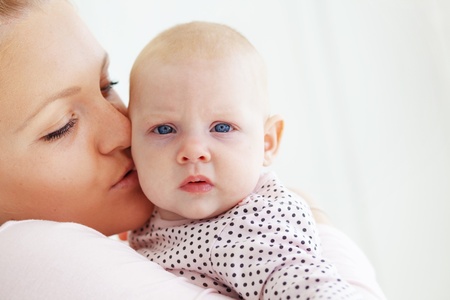Understanding Common Baby Eye Injuries
As a dad, I know how fast babies can get themselves into little scrapes—especially when it comes to their eyes. Babies are naturally curious and tend to reach for anything within sight, which means eye injuries are more common than we’d like to think. The most typical eye injuries you might see include scratches on the surface of the eye (corneal abrasions), pokes from tiny fingers or toys, and foreign objects like dust or small bits of debris getting stuck in their eyes. Recognizing these injuries quickly is key: look out for symptoms like excessive tearing, redness, constant rubbing, sensitivity to light, or if your baby just seems extra fussy and won’t open one eye. Knowing what these signs mean helps you act fast and keeps your little one’s vision safe.
2. What to Do First: Assessing the Situation
When you first notice something is wrong with your babys eye, its natural to feel anxious. The most important thing you can do is to stay calm—your baby picks up on your emotions quickly. Here’s how you can safely assess the situation step by step:
Simple Steps to Check Your Babys Eyes Safely
- Gently wash your hands before touching your baby or their face.
- Pick up your baby and hold them securely in your lap. Use a soft, soothing voice and gentle touch to help keep them calm.
- Look at the injured eye closely but do not force it open if they resist. Check for visible signs like redness, swelling, discharge, blood, or anything stuck in the eye.
- If possible, compare both eyes to spot any obvious differences.
Table: Signs of Minor vs. Serious Eye Injury
| Minor Injury | Serious Injury |
|---|---|
| Mild redness or irritation | Bleeding from the eye or eyelid |
| Tears more than usual | Pupil size changes or irregular shape |
| Small speck (like dust) visible | Visible object stuck that cant be removed easily |
| No vision changes | Baby keeps rubbing or won’t open eye; seems in pain |
How to Keep Everyone Calm
- Use a soft tone and reassuring words like “It’s okay” or “Daddy’s here.”
- Singing softly or offering a favorite toy can distract and comfort your baby.
- If you’re feeling nervous, take a deep breath before moving forward—your calmness helps your baby stay relaxed.
Remember:
If you see any signs of a serious injury from the table above, call your pediatrician or seek emergency care right away. Stay as calm as possible so you can help your little one through this situation safely.
![]()
3. Immediate First Aid for Minor Eye Injuries
When your baby gets something in their eye or suffers a minor scratch, it’s natural to feel panicked. But staying calm is the best way to help. Here’s what you can do right away to protect your little one’s eyes and prevent further damage.
Rinse the Eye Gently
If you see dust, dirt, or another small irritant in your babys eye, try to rinse it out with clean, lukewarm water. You can use a small cup or an eyedropper, or simply let clean water run over the open eye while holding your baby securely. This helps flush out any foreign particles without rubbing or causing more irritation.
Remove Visible Particles Carefully
If there’s something visible on the white part of the eye or under the lower eyelid, you can try to remove it gently. Wash your hands thoroughly first. Then, using a damp cotton swab or corner of a clean cloth, lightly touch the particle to lift it out. Never attempt this if the object is stuck in the eye or if your baby seems to be in severe pain—leave that to medical professionals.
What NOT To Do
Do not rub your baby’s eye or let them rub it, as this could scratch the surface and make things worse. Don’t use tweezers or any sharp objects near their eyes. Avoid trying to remove anything that looks embedded or if there is bleeding—seek medical attention right away.
When In Doubt, Call Your Pediatrician
If you’re unsure about what’s in your baby’s eye or how serious it is, don’t take chances. It’s always better to call your pediatrician for guidance or head to urgent care if you’re worried about infection, swelling, or changes in vision.
4. When to Call the Doctor or Head to the ER
As a parent, its tough to know when an eye injury is something you can handle at home and when its time to get professional help. Eye injuries in babies can be tricky because our little ones cant tell us exactly what theyre feeling. In the U.S., certain symptoms mean you shouldnt wait—immediate medical attention is needed. Heres a straightforward guide to help you decide when its time to call your pediatrician or head straight to the ER.
Emergency Symptoms You Should Never Ignore
| Symptom | What It Could Mean | Action Needed |
|---|---|---|
| Bleeding from the eye or eyelid | Possible cut, deep scratch, or internal injury | Go to the ER immediately |
| Baby cannot open their eye or keeps it tightly shut | Severe pain, possible foreign object or chemical injury | Seek urgent care right away |
| Pupil looks abnormal (different size, shape, or color) | Possible serious trauma inside the eye | Call 911 or go to the ER now |
| Sudden swelling around the eye (especially with redness and warmth) | Could be infection or allergic reaction | Call your doctor; may need same-day care |
| White, yellow, or green discharge from the eye | Sign of infection that needs prompt treatment | Contact your pediatrician as soon as possible |
| Loss of vision, double vision, or baby seems unable to focus on objects | Nerve damage or other serious problem affecting sight | Go to the ER immediately |
| Chemical splashes (cleaners, detergents, etc.) in the eye | Chemical burns can cause permanent damage quickly | Irrigate with water for 15-20 minutes and head to the ER without delay |
| Bruising around both eyes (“raccoon eyes”) | This could signal a skull fracture from head trauma | Call 911 or go directly to the ER |
| A foreign object stuck in the eye that can’t be flushed out easily (not just dust) | Painful abrasions or risk of deeper injury if not removed properly | Do not try to remove it yourself; see a doctor immediately |
| Your gut tells you “something’s not right” even if symptoms seem mild | You know your child best—trust your instincts! | If worried, call your pediatrician for guidance right away |
The American Approach: Urgent vs. Emergency Care for Babies’ Eyes
In the U.S., here’s how most parents handle these situations:
- If you see blood, abnormal pupil shapes, loss of vision, or chemical injuries: Go directly to the ER—don’t wait for an appointment.
- If there’s swelling, pus/discharge, or your baby refuses to open their eye: Call your pediatrician ASAP. If it’s after hours and symptoms are severe, urgent care clinics are a good backup.
- If you’re ever unsure: It’s always better to play it safe. Pediatricians are used to these calls and would rather help you figure it out than have you take a risk.
Remember:
Your baby’s eyes are precious and delicate. Fast action can prevent lasting problems. Don’t hesitate if you notice anything on this list—your quick decision could make all the difference.
5. Common Mistakes Parents Make (And How to Avoid Them)
When your baby gets an eye injury, it’s totally normal to feel panicked—trust me, I’ve been there. But in the heat of the moment, American parents often make a few common mistakes that can make things worse or slow down healing. Here’s what to watch out for, and some everyday language tips to help you keep your cool.
Don’t Rub or Let Your Baby Rub Their Eye
This one’s tough, especially with little ones who want to touch everything. Rubbing can actually push debris further in or cause scratches. If you catch yourself saying, “Just let me see!” while swatting their hand away, try using a calm voice: “Let’s keep those hands down so we can help your eye feel better.” Distraction helps—a favorite toy or silly song works wonders.
Avoid Home Remedies and Old Wives’ Tales
Your neighbor might swear by milk drops or herbal rinses, but these aren’t safe for baby eyes and could do real harm. In the U.S., pediatricians recommend only sterile saline (or clean water if nothing else is available). Remember: If you wouldn’t eat it, don’t put it in your child’s eye.
Don’t Delay Medical Care When It’s Needed
Sometimes parents hope things will just get better with time, but certain eye injuries need urgent help—like cuts, chemical splashes, or anything that looks serious. If you find yourself hesitating (“I don’t want to overreact”), it’s better to call your pediatrician or head to urgent care just to be safe. No one will judge you for being cautious.
Trying to Remove Stuck Objects Yourself
If something is stuck in the eye (not just floating on the surface), don’t try to dig it out with tweezers or fingers—this is a big no-no. Cover the eye loosely and get professional help right away.
Forgetting About Hand Hygiene
In stressful moments, it’s easy to forget about washing your hands first. Dirty hands can introduce infection. Just take a breath and say out loud, “Let me wash up first,” even if you’re in a hurry. It sets a good example for older siblings too!
Final Tip: Breathe and Reassure
The best thing you can do is stay as calm as possible—your baby picks up on your vibes. Even if you’re freaking out inside, use simple phrases like “You’re safe” and “We’re going to fix this together.” Handling stress well not only helps your child, but also makes first aid go more smoothly for everyone involved.
6. Preventing Eye Injuries at Home
As a dad, I know that curious little hands get into everything, and its our job to make sure our homes are as safe as possible—especially when it comes to protecting those precious baby eyes. Here are some practical tips you can easily fit into your daily American family routine to childproof your space and reduce the risk of eye injuries.
Keep Dangerous Objects Out of Reach
Babies love to grab and explore, so store sharp objects like scissors, pens, keys, and even remote controls in drawers or cabinets with childproof locks. Remember, even common household items can cause serious eye injuries if left within reach.
Secure Furniture and Corners
Coffee tables, TV stands, and other furniture with sharp edges are right at baby’s eye level when they start crawling or walking. Install corner guards and edge bumpers on low tables and shelves. It’s a small investment that can prevent big accidents.
Be Mindful of Toys
Choose age-appropriate toys without small parts that could break off and avoid anything with pointy edges or projectile features (like dart guns). Regularly inspect toys for wear and tear—broken pieces can quickly turn dangerous.
Bathroom & Kitchen Safety
Store cleaning products, personal care items like nail scissors, and kitchen utensils high up or behind locked doors. The bathroom is full of unexpected hazards, so keep toilet lids closed and never leave your baby unattended where water or chemicals are present.
Watch for Household Chemicals
Cleaning sprays, detergents, and air fresheners should always be out of sight and reach. Use safety latches on lower cabinets. If you’re using chemicals while your little one is around, be extra vigilant about spills or residue on surfaces they might touch.
Supervision Is Key
No matter how well you childproof your home, there’s no substitute for keeping an eye on your child. Try to keep play areas visible from where you spend most of your time—like the kitchen or living room—and encourage safe play habits early on. By taking these simple steps, we can help protect our kids’ eyesight and give ourselves peace of mind as parents.


